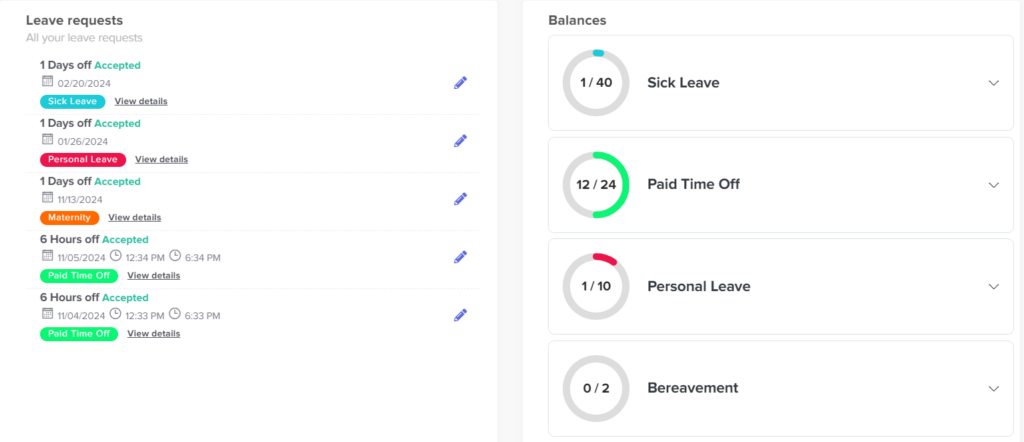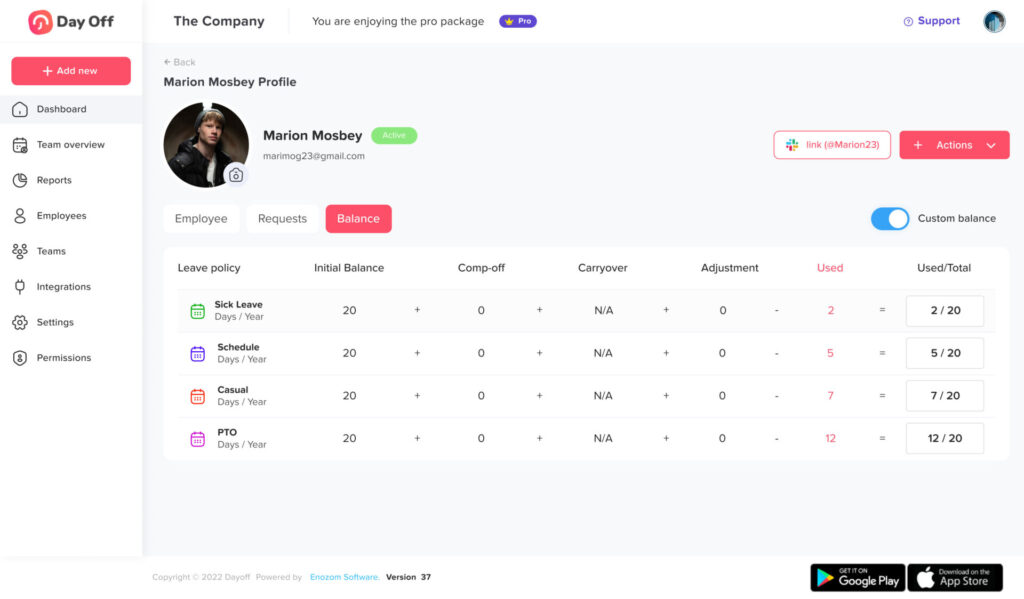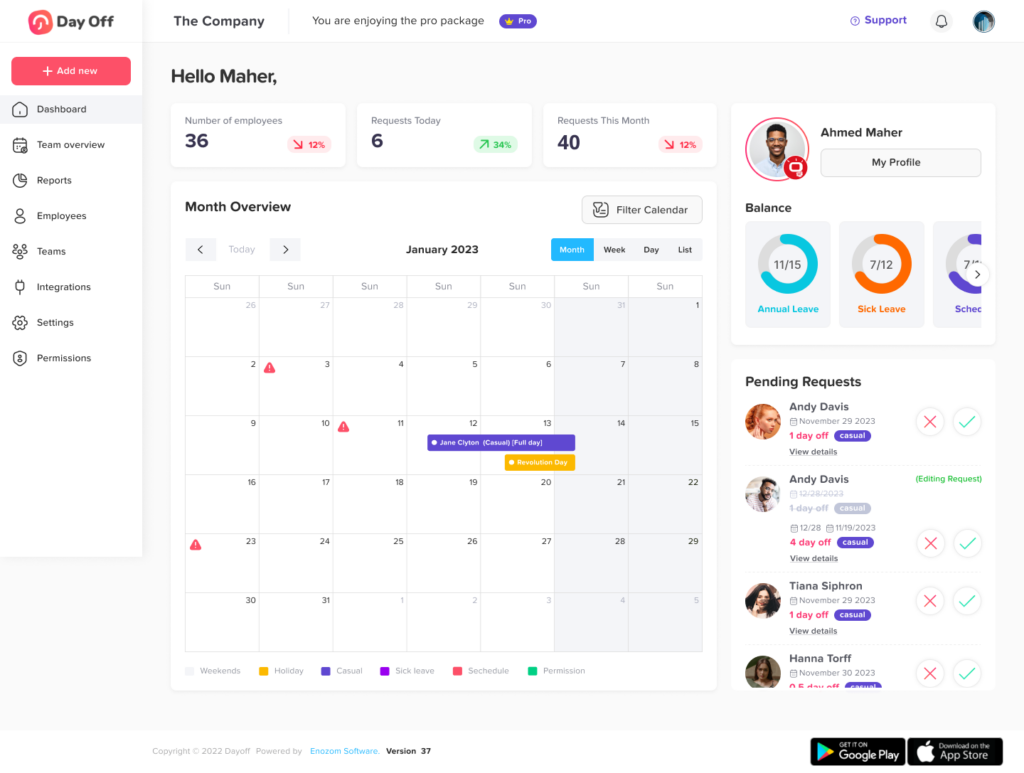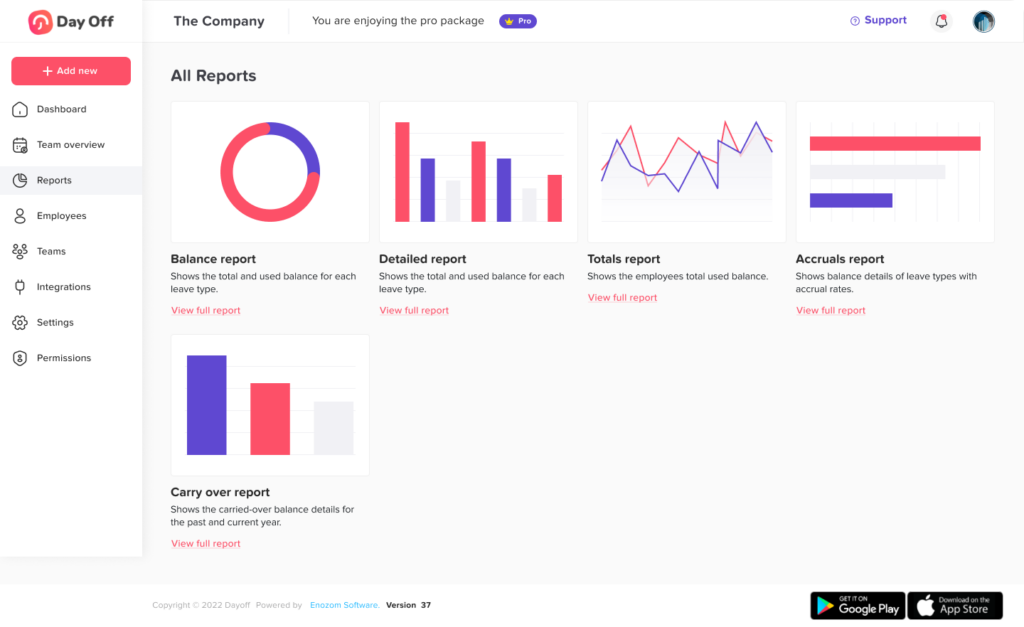Table of Contents
ToggleImagine a world where scheduling a vacation doesn’t involve a tangle of emails, paperwork, and endless back-and-forths with HR. Welcome to the realm of Time Off or Paid Time Off (PTO) Tracking Software, a modern solution to an age-old problem that’s revolutionizing the way companies and employees interact with the concept of taking a day off.
Managing employee time off can be a hard work. Yet, the adoption of Time Off or Paid Time Off (PTO) Tracking Software is revolutionizing how organizations handle vacation requests, sick leave, and other types of absence. Beyond simplifying administrative processes, this technology offers a range of surprising benefits that contribute to the overall efficiency, morale, and productivity of a workplace. This article explores the multifaceted advantages of implementing PTO tracking software, providing insights, details, and examples of its impact.
Enhanced Accuracy and Efficiency
Traditional methods of tracking time off, often reliant on spreadsheets or paper forms, are prone to errors and inconsistencies. PTO tracking software automates the process, significantly reducing the likelihood of mistakes.
For instance, when employee requests time off, the software automatically updates the available balance, eliminating the need for manual calculations. This precision is crucial for maintaining accurate records and ensuring fairness in time off entitlements.

Improved Transparency and Employee Satisfaction
One of the standout features of PTO tracking software is its ability to offer real-time visibility into leave balances and requests. Employees can easily access their information, submit requests, and view the status of pending applications, all from a centralized platform. This transparency implies a sense of equality and fairness, contributing to higher levels of employee satisfaction.
For example, a study by the Society for Human Resource Management (SHRM) indicated that transparency in leave policies and ease of access to PTO balances are correlated with increased employee morale.

Streamlined Administrative Processes
The administrative burden of managing time off requests can be considerable, especially for HR departments in larger organizations. PTO tracking software streamlines these processes by automating approvals, notifications, and record-keeping. This not only frees up HR professionals to focus on more strategic tasks but also speeds up the response time for leave requests, enhancing the overall efficiency of the organization.

Data-Driven Decision Making
With advanced reporting capabilities, PTO tracking software provides valuable insights into absence patterns, peak vacation times, and potential staffing shortages. This data can inform decision-making around staffing levels, project timelines, and workforce planning. For instance, if the software reveals a trend of high absenteeism during certain periods, management can proactively adjust staffing or explore underlying causes to mitigate the impact on productivity.

Reduced Compliance Risks
Navigating the complexities of labor laws and leave entitlements can be challenging, particularly for organizations operating in multiple jurisdictions. PTO tracking software helps reduce compliance risks by incorporating legal requirements into the system, ensuring that leave policies adhere to relevant laws and regulations. This feature is invaluable for avoiding legal pitfalls and maintaining good standing with labor standards.
Supporting Remote and Hybrid Work Models
As remote and hybrid work arrangements become more prevalent, managing time off in a distributed workforce requires a robust solution. PTO tracking software facilitates this by offering a centralized platform accessible from anywhere, at any time. This capability ensures that remote employees remain connected to the organization’s leave policies and procedures, promoting inclusivity and consistency across diverse work settings.
Day Off Vacation Tracker

Day Off Tracker shines when it comes to doing the heavy lifting of leave management. It makes dealing with any kind of time off, be it a quick day off or longer leaves, a breeze. Thanks to its easy-to-use design, everyone from employees to managers can sort out leave requests without any hassle, creating a happier and more productive work atmosphere.
What’s really cool about Day Off Tracker is how it lets businesses tweak leave policies to fit their unique needs. Startups are all about doing things differently, and this tool gets that. Whether it’s changing how fast leave adds up, setting up different kinds of time off (like sick days or personal days), or even sorting out holiday schedules, Day Off Tracker is all about flexibility.
Another big plus is that employees can see their leave balance any time they want. No more guessing or having to ask around. This means everyone knows exactly how much leave they have, making planning time off easier and keeping everyone aware of his balance.
By focusing on being easy to use, flexible, and super clear, Day Off Tracker is not just about keeping track of time off. It’s about making sure HR department can keep their teams happy and everything running smoothly.
Frequently Asked Questions (FAQ) About PTO Tracking Software
What is PTO Tracking Software?
PTO Tracking Software, also known as Paid Time Off Management Software, is a digital tool designed to automate and streamline the process of managing employee leave, vacations, and absences. It replaces manual tracking methods such as spreadsheets or paper forms with an intuitive, cloud-based platform. Through this system, employees can request time off, check their leave balances, and receive approvals instantly, while HR teams can monitor and report on attendance trends more efficiently.
Why should a company use PTO tracking software instead of spreadsheets?
Traditional spreadsheets may seem simple, but they’re prone to human error, difficult to update in real-time, and lack transparency. PTO tracking software eliminates these issues by automating calculations, approvals, and reporting. The system updates balances automatically, prevents scheduling conflicts, and ensures consistency across the organization. Additionally, digital solutions provide audit trails and compliance tracking, which spreadsheets can’t offer. This results in greater accuracy, time savings, and enhanced employee trust.
How does PTO tracking software improve accuracy and efficiency?
Accuracy and efficiency are two of the biggest benefits of adopting PTO software. Each time an employee submits a leave request, the system automatically adjusts their remaining balance and records the absence without manual input. It also notifies managers for approval and syncs with integrated calendars (such as Google Calendar, Outlook, Microsoft Teams, or Slack) to reflect updated schedules. This automation reduces administrative workload, minimizes calculation errors, and ensures real-time accuracy in employee leave records.
What types of leave can PTO tracking software manage?
Modern PTO tracking software supports various types of leave, including:
-
Vacation or annual leave
-
Sick leave and medical absences
-
Personal days
-
Maternity and paternity leave
-
Public holidays
-
Unpaid or special leave
-
Custom leave types, which companies can configure to fit their policies.
With tools like Day Off Tracker, organizations can customize leave categories, accrual rates, and approval workflows to align with their internal policies and legal requirements.
How does PTO tracking software enhance transparency for employees?
Transparency is one of the most appreciated benefits of PTO tracking software. Employees can log in at any time to view their leave balances, request history, and upcoming time off without needing to contact HR. Real-time visibility ensures fairness and helps employees plan their vacations or personal days confidently. This openness reduces misunderstandings, improves trust, and strengthens the sense of equality in the workplace.
Is PTO tracking software beneficial for remote or hybrid teams?
Absolutely. In today’s flexible work environment, remote and hybrid teams rely on centralized digital systems for collaboration and coordination. PTO tracking software provides cloud-based access, allowing employees and managers to manage leave from anywhere, at any time. This accessibility ensures consistent policy enforcement and helps distributed teams stay aligned on availability, minimizing scheduling conflicts and communication delays.
How does PTO software help with compliance and labor laws?
Compliance with labor laws is critical, especially for companies operating across multiple regions or countries. PTO tracking software integrates regulatory frameworks and leave entitlements into its system to ensure adherence to federal, state, or provincial labor laws. The platform can automatically calculate leave accruals based on tenure and local requirements, preventing accidental violations. Additionally, it maintains detailed records that simplify audits and HR reporting, helping organizations remain compliant effortlessly.
What are the main features to look for in a PTO tracking system?
When evaluating PTO tracking solutions, companies should consider features such as:
-
Automated leave requests and approvals
-
Customizable leave types and accrual policies
-
Real-time leave balance tracking
-
Integration with calendars and HR software
-
Multi-location and multi-policy support
-
Analytics and reporting dashboards
-
Mobile app access for on-the-go management
-
Data security and cloud-based backup
Tools like Day Off Vacation Tracker offer all these features in a user-friendly interface, making leave management simple and transparent.
How can PTO tracking software improve employee satisfaction and morale?
By providing clarity and convenience, PTO tracking software directly contributes to a more positive workplace culture. Employees appreciate being able to manage their own leave independently and knowing their requests are handled fairly. The transparency and speed of approvals eliminate frustration, while clear visibility into their PTO balances helps them plan personal time effectively. This promotes better work-life balance, leading to happier and more engaged employees.
Can PTO tracking software integrate with existing HR or payroll systems?
Yes, most PTO tracking tools, including Day Off, offer seamless integrations with popular HRIS (Human Resource Information Systems), payroll software, and calendar applications. This synchronization ensures that approved time off automatically updates employee schedules and payroll calculations. Such integration minimizes administrative duplication, ensures payroll accuracy, and creates a unified HR ecosystem that improves overall efficiency.
How does PTO tracking software support data-driven decision-making?
PTO tracking software collects valuable data on employee absences, trends, and patterns. HR professionals can analyze this information through built-in analytics dashboards and reports to identify patterns such as seasonal absences or potential burnout risks. These insights help in optimizing workforce planning, managing workloads, and forecasting staffing needs. Data-driven insights also enable HR to develop more effective leave policies and wellness initiatives.
Is PTO tracking software suitable for small businesses?
Definitely. PTO tracking software isn’t just for large enterprises, it’s an ideal solution for startups and small businesses looking to streamline their operations. Many tools, like Day Off PTO Tracker, are affordable, easy to implement, and scalable as a company grows. They reduce administrative workload and help smaller teams maintain professionalism and compliance without investing heavily in HR infrastructure.
How secure is employee data in PTO tracking systems?
Security is a top priority for PTO tracking providers. Most platforms use cloud-based storage with encryption protocols, ensuring that sensitive employee information such as names, balances, and schedules remains safe. Regular system updates, access controls, and data backups add extra layers of protection. Reputable tools like Day Off adhere to international data protection standards such as GDPR, ensuring full confidentiality and compliance.
Can PTO tracking software help reduce absenteeism?
Yes, indirectly. By providing visibility into time-off trends and encouraging proactive leave planning, PTO tracking software helps managers identify patterns of absenteeism before they become problematic. Employees are also less likely to take unplanned absences when they feel confident their legitimate leave requests will be handled promptly. In turn, this leads to better attendance, improved morale, and more balanced workloads across teams.
How does Day Off PTO Tracker stand out from other software options?
Day Off Tracker distinguishes itself through its simplicity, customization, and integrations. It allows companies to tailor leave policies, accrual rules, and approval hierarchies based on their unique needs. The interface is designed to be intuitive for both employees and managers, minimizing training time. Integration with Google Calendar, Outlook, Microsoft Teams, and Slack enhances communication and coordination. Beyond tracking time off, Day Off fosters a culture of transparency, trust, and work-life balance, essential for today’s modern workplace.
How does implementing PTO tracking software impact HR departments?
For HR professionals, PTO tracking software is a game-changer. It automates time-consuming administrative tasks such as manual leave tracking, approval routing, and report generation. This allows HR teams to focus on strategic initiatives like talent management, employee engagement, and performance optimization. With built-in reporting tools, HR gains clearer insights into workforce trends, helping to make more informed and impactful decisions.
Can PTO tracking software be accessed via mobile devices?
Yes, most leading PTO tracking systems, including Day Off, offer mobile-friendly interfaces or dedicated apps. Employees and managers can submit, approve, or view leave requests directly from their smartphones, making the system accessible anytime, anywhere. This is especially beneficial for field workers, remote teams, or employees who travel frequently, ensuring everyone remains connected and informed.
What is the ROI (Return on Investment) of implementing PTO tracking software?
The return on investment comes from reduced administrative time, improved accuracy, and higher employee satisfaction. Automating leave management can save HR teams hours each week, minimize payroll errors, and decrease absenteeism costs. Moreover, by enhancing transparency and work-life balance, the software contributes to better employee retention, which significantly lowers recruitment and onboarding expenses. In the long run, PTO tracking software pays for itself through efficiency and productivity gains.
How can a company successfully implement PTO tracking software?
Successful implementation involves a few key steps:
-
Assess current leave policies and ensure they’re clearly defined.
-
Select a software solution that aligns with your company’s size, structure, and needs.
-
Customize settings such as accrual rates, leave types, and approval workflows.
-
Train employees and managers on how to use the system.
-
Monitor and evaluate performance metrics post-launch.
Tools like Day Off PTO Tracker simplify the transition by offering easy onboarding, real-time support, and integrations that ensure minimal disruption during setup.
What is the future of PTO tracking and leave management?
The future of leave management lies in automation, integration, and predictive analytics. As organizations embrace hybrid and global work models, PTO software will continue evolving to offer more intelligent insights, policy flexibility, and seamless integration with other HR systems. Features like AI-driven absence forecasting and wellness analytics will help companies proactively manage workforce well-being. Platforms like Day Off are leading this transformation by combining simplicity, flexibility, and innovation.
Conclusion
The adoption of Time Off or PTO Tracking Software extends beyond mere administrative convenience, offering a suite of surprising benefits that enhance accuracy, efficiency, transparency, and compliance. By providing real-time access to information, streamlining processes, and delivering valuable insights into absence trends, this technology plays a pivotal role in fostering a positive work environment. As organizations continue to navigate the complexities of modern work arrangements, the strategic implementation of PTO tracking software will remain a critical tool in optimizing workforce management and productivity.
